VERS UNE MEMOIRE QUANTIQUE AVEC DES IONS PIEGES
VERS UNE MEMOIRE QUANTIQUE AVEC DES IONS PIEGES
VERS UNE MEMOIRE QUANTIQUE AVEC DES IONS PIEGES
You also want an ePaper? Increase the reach of your titles
YUMPU automatically turns print PDFs into web optimized ePapers that Google loves.
tel-00430795, version 1 - 9 Nov 2009<br />
122 CHAPITRE 5. CHARGEMENT DU PIÈGE<br />
Photoionisation loading of large Sr + ion clouds with ultrafast pulses. 5<br />
1000 trapped ions. In fact, with TPPI an optimum of<br />
4 × 10 4 trapped Sr + ions is obtained for Vrf = 125 V.<br />
In the case of EB it is impossible to explore the same<br />
range for the parameter Vrf without affecting the sample<br />
purity, since too many spurious ionic species, of mass<br />
lower than Sr, are produced and trapped at low Vrf .<br />
This effect is clearly visible in the mass spectra of Figure<br />
6b obtained with the two techniques in an intermediate<br />
regime (Vrf = 350 V). Therefore, in our case of a noncrystalized<br />
regime, the possibility to work at a low Vrf<br />
is crucial in order to obtain a large number of trapped<br />
ions. We interpret this result in terms of rf-heating process<br />
that increases with Vrf [30]. In this situation, and<br />
in the presence of laser-cooling, the ion-density depends<br />
on the balance between cooling and heating. A maximum<br />
density is then achievable by minimizing Vrf (i.e.<br />
the rf heating) within the stability region. But the total<br />
number of trapped ions also depends on the volume<br />
of the trap that is imposed by Vrf and Vec. Numerical<br />
simulations carried-out using Simion R○ software[26] allowed<br />
us to estimate the trap volume as a function of<br />
Vrf for Vec = 500 V. An optimum (maximum) volume<br />
is obtained for Vrf = 180 V, slightly larger than the<br />
experimental value that maximizes the total number of<br />
trapped ions. Let us note that for low-temperature samples<br />
(e.g. in crystallized regime) the ion density increases<br />
by increasing Vrf , provided that the rf-heating remains<br />
low enough to prevent the melting of the crystal.<br />
We also observed that, when working in the regime of<br />
relatively high Vrf , that is optimal for EB (Vrf = 500V ),<br />
1100±5% ions can be trapped by EB to be compared to<br />
1200 ± 5% ions obtained by photoionisation. This small<br />
discrepancy might be explained by space charge effects<br />
due to electrons that can perturb the trap electrostatic<br />
potential. Let us also finally remark that the selectivity<br />
of the TPPI technique allowed us to load pure Sr + clouds<br />
in the trap at very low oven temperatures (on the order<br />
of 120 ◦ C), contrary to the case of EB (on the order<br />
of 165 ◦ C). As mentioned above, this lower temperature<br />
implies a vapour pressure reduction of several orders of<br />
magnitude.<br />
4 Conclusion<br />
We demonstrated the loading of Sr + in a linear Paul trap<br />
using two-photon absorption of ultrafast pulses centered<br />
at 431 nm. We compared this technique to the electron<br />
bombardment loading and observed several advantages,<br />
already mentioned in previous experiments concerning<br />
other species or other photo-excitation paths. In particular<br />
this technique allowed us to selectively load pure<br />
Sr + clouds, to explore trapping regimes with low RF<br />
voltages, to obtain large cooled-ion clouds, and to improve<br />
the vacuum quality by lowering the power in the<br />
Sr oven. Concerning this last point, it has been possible<br />
to reduce the expected Sr partial pressure near the<br />
oven filament by roughly 4 orders of magnitude. Our results<br />
have been obtained with a home-made femtosecond<br />
source that delivers relatively low energy pulses.<br />
We expect an improvement of two orders of magnitudes<br />
in the photoionization rate in the case of commercially<br />
available Ti:Sa oscillators delivering routinely 10 nJ per<br />
pulse. Let us finally mention that the trapping of up to<br />
4 × 10 4 cooled Sr + ions is an important step towards the<br />
realization of an ion-based quantum memory[31].<br />
5 Acknowledgments<br />
We thank P. Lepert for technical support. The authors<br />
would also like to thank M. Joffre for the loan of the femtosecond<br />
oscillator. This work was supported by ANR<br />
“jeunes chercheuses et jeunes chercheurs” research contract<br />
JC05 61454.<br />
References<br />
1. H. Häffner, C. F. Roos, and R. Blatt, Quantum computing<br />
with trapped ions, Phys. Rep. 469, 155 (2008)<br />
R. Blatt and D. Wineland, Entangled states of trapped<br />
atomic ions, Nature, 453, 1008 (2008).<br />
2. P. Gill, Optical frequency standards, Metrologia 42, S125-<br />
S137 (2005)<br />
3. G.R. Guthöhrlein, M. Keller, K. Hayasaka, W. Lange, H.<br />
Walther, A single ion as a nanoscopic probe of an optical<br />
field, Nature 414, 49 (2001) J. Eschner, C. Raab, F.<br />
Schmidt-Kaler, R. Blatt, Light interference from single<br />
atoms and their mirror images, Nature 413, 495 (2001)<br />
P. Herskind, A. Dantan, M.B. Langkilde-Lauesen, A.<br />
Mortensen, J.L. Sørensen, M. Drewsen, Loading of large<br />
ion Coulomb crystals into a linear Paul trap incorporating<br />
an optical cavity, Appl. Phys. B 93 373-379 (2008)<br />
4. N. Kjærgaard, L. Hornekær, A. M. Thommesen, Z.<br />
Videsen, M. Drewsen, Isotope selective loading of an<br />
ion trap using resonance-enhanced two-photon ionisation,<br />
Appl. Phys. B 71, 207-210 (2000)<br />
5. S. Gulde, D. Rotter, P. Barton, F. Schmidt-Kaler,<br />
R. Blatt, W. Hogervorst, Simple and efficient photoionisation<br />
loading of ions for precision ion-trapping experiments,<br />
Appl. Phys. B 73, 861-863 (2001)<br />
6. D. M. Lucas, A. Ramos, J. P. Home, M. J. McDonnell,<br />
S. Nakayama, J.-P. Stacey, S. C. Webster, D. N. Stacey,<br />
and A. M. Steane, Isotope-selective photoionisation for<br />
calcium ion trapping, Phys. Rev. A 69 012711 (2004)<br />
7. M. Brownnutt, V. Letchumanan, G. Wilpers, R. C.<br />
Thompson, P. Gill, A. G. Sinclair, Controlled photoionisation<br />
loading of 88 Sr + for precision ion-trap experiments,<br />
Appl. Phys. B 87 411-415 (2007)<br />
8. R. J. Hendricks, D. M. Grant, P. F. Herskind, A. Dantan,<br />
and M. Drewsen, An all-optical ion-loading technique for<br />
scalable microtrap architectures, Appl. Phys. B 88 507-<br />
513 (2007)<br />
9. D. R. Leibrandt, R. J. Clark, J. Labaziewicz, P. Antohi,<br />
W. Bakr, K. R. Brown, and I. L. Chuang, Laser ablation<br />
loading of a surface-electrode ion trap, Phys. Rev. A 76<br />
055403 (2007)


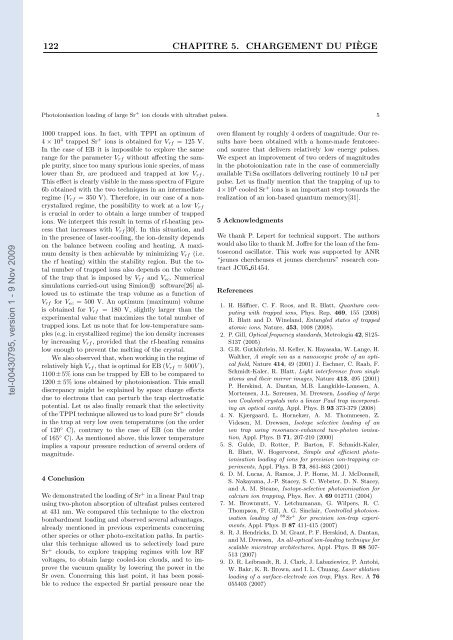

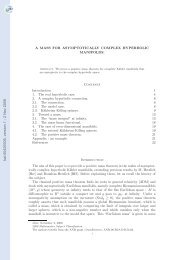
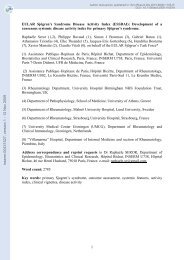
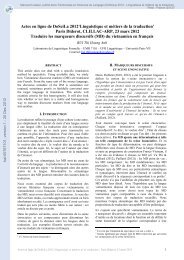
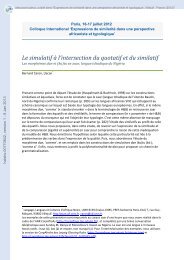
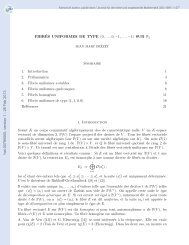
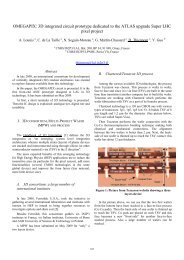
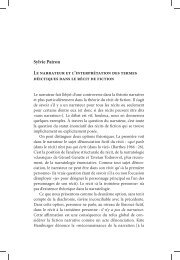
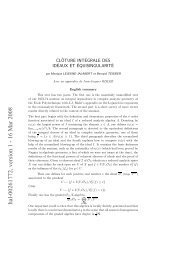
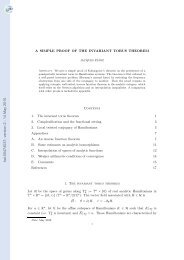

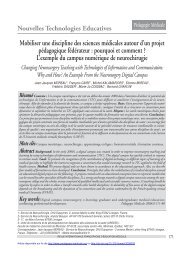

![[tel-00433556, v1] Relation entre Stress Oxydant et Homéostasie ...](https://img.yumpu.com/19233319/1/184x260/tel-00433556-v1-relation-entre-stress-oxydant-et-homeostasie-.jpg?quality=85)